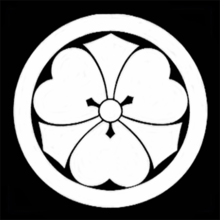Sakai Tadatsugu
| Sakai Tadatsugu | |
|---|---|
 portrait of Sakai Tadatsugu | |
| Born | 1527 |
| Died |
17 December 1596 Kyoto |
| Children | Sakai Ietsugu |
Sakai Tadatsugu (酒井 忠次, 1527 – 17 December 1596) was one of the most favored and most successful military commanders serving Tokugawa Ieyasu in the late-Sengoku period. He is regarded as one of the Four Guardians of the Tokugawa (Tokugawa-Shitennō).[1] along with Honda Tadakatsu, Ii Naomasa, and Sakakibara Yasumasa.
Sakai clan genealogy
The Sakai clan originated in 14th century Mikawa Province,[2] claiming descent from Minamoto Arichika. Arichika had two sons: one of them, Yasuchika, took the name Matsudaira; and the younger, Chikauji, took the name Sakai.[3]
Sakai Hirochika, who was the son of Chikauji, likewise had two sons, and their descendants gave rise to the two main branches of the Sakai clan.[4] Tadatsugu was heir to the senior branch of the clan.
Biography

Tadatsugu was born in 1527 to Sakai Tadachika, a hereditary vassal of the Matsudaira clan of Mikawa Province. When Tadatsugu came of age, he first served Tokugawa Ieyasu's father, Matsudaira Hirotada. After 1560, when Ieyasu broke off his ties with the Imagawa clan, Tadatsugu was given command of the Yoshida Castle [4] in eastern Mikawa (present-day Toyohashi).
During that time, it is said Tadatsugu killed a boar with his katana, earning it the name of the Inokiri (猪切 the Boar Slayer). The blade itself was a work of Masazane from the Tegai school of Nara, and a colleague of the famous Muramasa (or maybe another name for Muramasa himself). Masazane also authored Tonbōgiri (蜻蛉切 the Dragonfly Slayer), the most famous of the Three Great Spears of Japan (天下三名槍), favourite weapon of Honda Tadakatsu, another one of the Tokugawa Shitennō.
In 1572, during the Battle of Mikatagahara, Tadatsugu secured the Tokugawa's right flank, seeing his troops being badly beaten by the opposing Takeda forces; and when Ieyasu and his allies retreated to Hamamatsu Castle, Tadatsugu participated in the ruse which mitigated the effects of Takeda victory in the field; and the Takeda forces withdrew.[5][6]
During the Battle of Nagashino, he led a successful night attack against the Takeda.[7]
By 1567, the majority of daimyō forces in the Tokugawa armies were organized in two divisions, each with a separate commander. Tadatsugu was placed over the forces of 18 Tokugawa daimyō-vassels and his counterpart, Ishikawa Kazumasa, was given command over the forces of 13 daimyō-vassels.[8] Tadatsugu's qualities of proven loyalty, reliability, and leadership are demonstrably illustrated in this degree of delegated powers and authority.
In 1578, Tadatsugu's son, Sakai Ietsugu (1564–1619), took over his father's role as castellan of Yoshida Castle.[4] The ie- in the beginning of Ietsugu's name was a special honor bestowed by Tokugawa Ieyasu, a special reward for special vassals, allowing them to use one of the kanji from his Nanori name.[9]
During the Battle of Komaki and Nagakute, he successfully turned back a move by Toyotomi Hideyoshi against Kiyosu Castle, which was led by Toyotomi commander Mori Nagayoshi. In 1590, during the Odawara Campaign, Tadatsugu was ordered to accompany Tokugawa Hidetada, Ieyasu's son and heir, to Kyoto, where he served as hostage for Ieyasu's loyalty to the Toyotomi during that campaign. After the battle, Hideyoshi ordered to Tokugawa clan to relocate from their ancestral holdings to the Kantō region. Tadatsugu went into retirement, but his son Ietsugu received a 30,000 koku fudai fief at Usui, in Shimōsa Province, and Tadasugu accompanied them there.[4]
Tadatsugu died in Kyoto in the winter of 1596. After Tadatsugu's death, Sakai clan continued to prosper. In 1604, his descendants removed to Takasaki Domain (50,000 koku) in Kōzuke Province; in 1616, they relocated to Takata Domain (100,000 koku) in Echigo province; in 1619, they were transferred to Matsushiro Domain in Shinano province; and then, from 1622 through 1868, they were installed at Tsurugaoka Domain (120,000 koku) in Dewa province.[4] The head of the Sakai clan was ennobled as a "Count" in the Meiji period.[4]
References
- ↑ Chido Museum: Sakai clan history
- ↑ Appert, Georges et al. (1888). Ancien Japon, p. 76.
- ↑ Papinot, Jacques. (2003). Nobiliare du Japon -- Sakai, pp. 50-51; Papinot, Jacques Edmond Joseph. (1906). Dictionnaire d’histoire et de géographie du Japon. (in French/German).
- 1 2 3 4 5 6 Papinot, p. 50.
- ↑ Bryant, Anthony. (1994). Samurai, 1550-1600, p. 61.
- ↑ Turnbull, Stephen (2000). The Samurai Sourcebook. London: Cassell & C0. p. 222-223. ISBN 1854095234.
- ↑ Trumbull, Stephen. (2000) Nagashino 1575: Slaughter at the Barricades, p. 60.
- ↑ Jansen, Marius. (1995) Warrior Rule in Japan, p. 182.
- ↑ Plutschow, Herbert. (1995). "Japan's Name Culture: The Significance of Names in a Religious, Political and Social Context, p.53.
Further reading
- Appert, Georges and H. Kinoshita. (1888). Ancien Japon. Tokyo: Imprimerie Kokubunsha.
- Meyer, Eva-Maria. (1999). Japans Kaiserhof in de Edo-Zeit: Unter besonderer Berücksichtigung der Jahre 1846 bis 1867. Münster: Tagenbuch. ISBN 3-8258-3939-7
- Bryant, Anthony J. (1994). Samurai, 1550-1600. Oxford: Osprey Publishing. ISBN 1-85532-345-1
- Jansen, Marius B. (1995). Warrior Rule in Japan,. Cambridge: Cambridge University Press. ISBN 0-521-48404-9
- Papinot, Jacques Edmund Joseph. (1906) Dictionnaire d'histoire et de géographie du japon. Tokyo: Librarie Sansaisha...Click link for digitized 1906 Nobiliaire du japon (2003)
- Plutschow, Herbert. (1995). "Japan's Name Culture: The Significance of Names in a Religious, Political and Social Context. London: Routledge. ISBN 978-1-873410-42-4 (cloth)
- Turnbull, Stephen R. (2000). Nagashino 1575: Slaughter at the Barricades. Oxford: Osprey Publishing. ISBN 1-85532-619-1